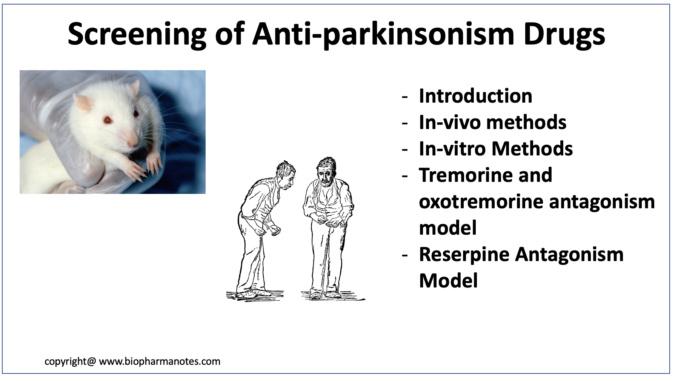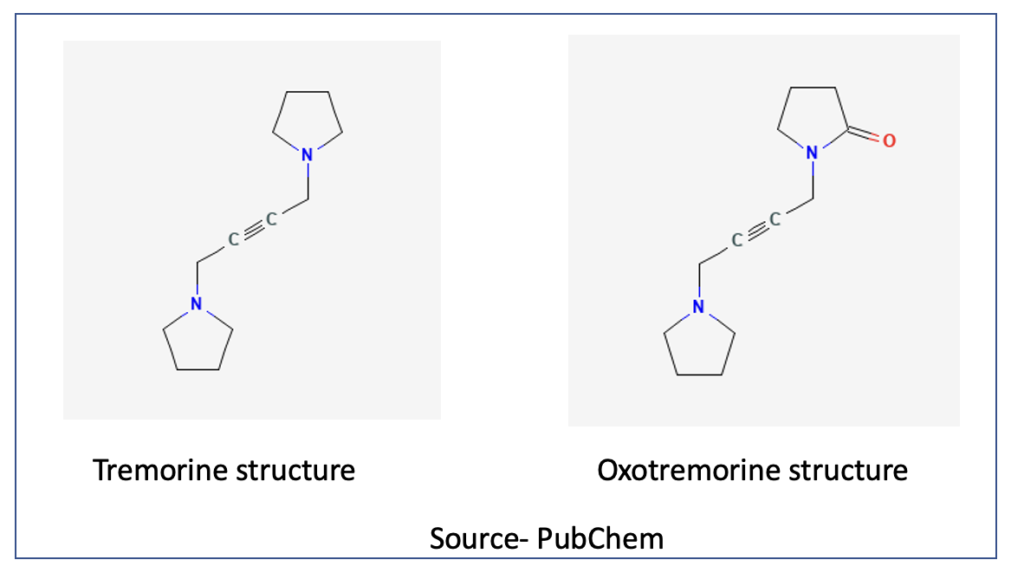
- Parkinson’s disease is a progressive neurological disorder with symptoms like muscular rigidity, tremor, dyskinesia, postural and gait abnormalities. It is characterized by death of dopaminergic neurons in substantia nigra.
- It cannot be completely cured. There are medications which are helpful in reducing symptoms and improving quality of life of patients with parkinsonism. Such medications include carbidopa- levodopa, selegiline, rasagiline, amantadine, dopamine receptor agonist like bromocriptine, some antimuscarinic agents.
Screening of anti-parkinsonism drugs
There are various methods of screening anti-parkinsonism drugs which can be broadly classified and in-vitro and in-vivo methods.
In-vivo methods
- Tremorine and oxotremorine antagonism
- Reserpine antagonism
- MPTP models in monkey
- Circling behavior in nigrostriatal lesioned rats
- Elevated Body swing test
- Skilled paw reaching in rats
- Stepping test in rats
In-vitro methods
- Dopamine stimulated adenylyl cyclase activity
- Dopamine release from synaptosomes
- Radioligand binding studies for D1 and D2 dopamine receptors.
Tremorine and oxotremorine Antagonism model

Purpose and Rationale
- Tremorine and oxotremorine are drugs used for producing symptoms of Parkinson’s like tremor, salivation, lacrimation, hypothermia, and ataxia in animals like rats and mice. The tremors mostly affect limbs and trunk.
Animals used
NMRI male mice (weight- 18-22 gm), number- 6-10
Procedure
- Before one hour of administering oxotremorine by subcutaneous route in mice, they are given oral administration of test drugs (drugs which are screened) and standard (5 mg/kg of benzatropine mesylate).
- Rectal temperature is measured before administering and after 1, 2 and 3 hours of oxotremorine injection. Tremor is measured after oxotremorine injection for 10 seconds every 15 minutes for 1 hour and is scored. Lacrimation and salivation are scored 15 and 30 minutes after oxotremorine injection.
- We can score it in following away.
Tremor/ salivation/ lacrimation Score
absent 0
slight 1
Medium 2
Severe 3
Evaluation
- The difference in body temperature after 1, 2 and 3 hours versus basal temperature is calculated and compared for control and test drugs.
- For salivation and lacrimation, scores of 2 observation for all animals in each group are summarized. Summarized score of treated groups is expressed as percentage of score of control group. For tremor also same method is used, however score of 3 observations is summarized here.
Pros and Cons
- It is one of the reliable methods for screening anti-cholinergic drugs.
- It screens only central anticholinergic activity of drugs.
Reserpine antagonism model

Purpose and rationale
- Reserpine– an alkaloid found in roots of plant Rauwolfia Serpentina can cause depletion of catecholamines, adrenaline and dopamine from different storage areas including CNS. When injected in mice, it can induce catalepsy (akinesia and bradykinesia), tremulous jaw movements and other symptoms of Parkinson’s disease.
Animals used
NMRI mice of either sex weighing around 20-25 gm.
Procedure
- Mice are divided in two groups- control and test group.
- Reserpine is administered intraperitoneally (5mg/kg) before 24 hours of testing. After 24 hours, test drug is administered in test and control groups are treated with vehicle only.
- After 30 minutes, locomotor activity is observed and recorded by placing mice on floor of Perspex container.
Evaluation
- Locomotor activity and grooming scores are measured and compared between test and control group.
References
- https://www.mayoclinic.org/diseases-conditions/parkinsons-disease/diagnosis-treatment/drc-20376062
- https://en.wikipedia.org/wiki/Tremorine
- https://en.wikipedia.org/wiki/MPTP
- https://www.slideshare.net/SONALPANDE5/screening-of-antiparkinson-agent
- Movement Disorders (Second Edition). Genetics and Models. 2015, Pages 631-640.
- Armstrong MJ et al. Diagnosis and Treatment of Parkinson Disease A Review. JAMA. 2020;323(6):548-560.
- Front. Pharmacol., 04 October 2017 | https://doi.org/10.3389/fphar.2017.00700
- Massari MC et al. Antiparkinsonian Efficacy of Guanosine in Rodent Models of Movement Disorder.Front Pharmacol. 2017.
- Drug discovery and Evaluation. Pharmacological Assays. 2nd edition.
- Pharmacology and pharmacotherapeutics. 24th edition.